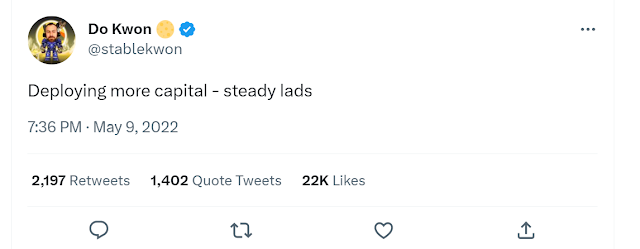Summary:
The last week or so has seen some of the worst bank communications since 2007, when the Bank of England started a bank run by leaking news of Northern Rock's emergency liquidity request to the journalist Robert Peston. Then as now, awful communications have frightened the horses, triggered stampedes and caused banks to fail. Three banks in particular have shown an extraordinary insensitivity to popular fears: Silicon Valley Bank, Credit Suisse, and Wells Fargo. Two of these have paid a heavy price for their management's inept handling of vital communications. But the third seems to have got away with it - this time. Next time, it might not be so lucky. Exhibit 1: Silicon Valley Bank (SVB)In the wake of Silvergate Bank's failure, Silicon Valley Bank decided to restructure its balance
Topics:
Frances Coppola considers the following as important:
banks,
Credit Suisse,
Silicon Valley Bank,
Silvergate,
Wells Fargo
This could be interesting, too:
Bill Haskell writes FDIC: Number of Problem Banks Increased in Q1 2024
Angry Bear writes The “Wayback Machine” and Rescuing Problem Banks
Angry Bear writes The Lie Banks Use To Protect Late-Fee Profits
Bill Haskell writes The Demise of Credit Suisse, Who is to blame?
The last week or so has seen some of the worst bank communications since 2007, when the Bank of England started a bank run by leaking news of Northern Rock's emergency liquidity request to the journalist Robert Peston. Then as now, awful communications have frightened the horses, triggered stampedes and caused banks to fail.
Three banks in particular have shown an extraordinary insensitivity to popular fears: Silicon Valley Bank, Credit Suisse, and Wells Fargo. Two of these have paid a heavy price for their management's inept handling of vital communications. But the third seems to have got away with it - this time. Next time, it might not be so lucky.
Exhibit 1: Silicon Valley Bank (SVB)
In the wake of Silvergate Bank's failure, Silicon Valley Bank decided to restructure its balance sheet.
SVB's
full-year accounts released in February revealed that it was backing highly volatile uninsured deposits with long-dated government securities that were falling in value and, as a result, becoming increasingly illiquid. To make matters worse, it was flattering its capital position by classing most of these securities as held-to-maturity even though it was obvious that in the event of a bank run it would have to raise cash by selling or pledging them at fair value. SVB was desperately short of liquidity and, on a fair value basis, had negative equity. But management sat on its hands - until Silvergate failed.
Silvergate's failure was a massive wakeup call for SVB. Suddenly, the duration mismatch and illiquidity that management had been ignoring became an existential crisis.
Reuters reports that the ratings agency Moody's threat to downgrade the bank's credit rating prodded SVB's management into action. They hastily cobbled together a plan to sell $21bn of long-dated bonds and replace them with short-dated, liquid securities, financed by a $2.25bn capital raise. On 8th March, they announced the plan and sold the bonds at a loss of $1.8bn.
SVB's decision to shorten the duration of its US government bond portfolio and raise more capital was eminently sensible, though far too late and nowhere near enough. But the market took it to mean the bank was in deep trouble. The bank had sold the securities before raising the capital, which gave the impression that it was desperately short of cash. And announcing a $1.8bn loss with only $500m of the capital raise needed to finance it guaranteed didn't go down at all well with investors. The share price collapsed.
Over the next 24 hours, $42 billion of uninsured deposits fled the bank. By the end of Thursday 9th March, SVB had overdrawn its reserve account at the Fed by nearly $1bn and was completely unable to find the collateral to convert this to authorised borrowing. The California Department of Financial Protectio and Innovation (CA DFPI), SVB's regulator,
decided it was insolvent, obtained
a court order to close it down and handed it over to the FDIC for resolution.
This is a fine example of what we might term the Peston effect. An announcement intended to reassure markets and prevent a bank run had precisely the opposite effect. And like a genie, once the announcement was out of its bottle it proved impossible to control. News that SVB was in trouble spread far and wide on social media, helped by powerful influencers whose motives for spreading it were perhaps less than entirely honourable.
Many have commented on the role of social media in the failure of SVB. And it is certainly true that the power of social media to amplify bad rumours contributed greatly to the extraordinary speed of the bank's collapse. But if the bank's management hadn't sat on its hands until it was forced to act then made an utter horlicks of communicating its plans, there wouldn't have been a bad rumour to spread, and the bank might still be standing today.
Exhibit 2: Credit Suisse
Credit Suisse has a history of terrible communications. In October 2022, a rumour spread on social media that "a Globally Systemically Important Bank" was on the brink of collapse. At that time, Credit Suisse was about to embark on a major restructuring in the hopes of ending a long run of terrible investment decisions and major losses. Analysts, including the armchair variety, put two and two together and decided that the failing G-SIB was Credit Suisse. Bond yields slumped and shares sold off.
The bank's Chief Executive, Ulrich Koerner, tried to calm things down. He sent a memo to staff saying that the bank's capital and liquidity were strong. The memo was widely reported in the press - for example, by the newswire Reuters, which
used the memo's wording as its headline:
He really shouldn't have used that phrase. Earlier that year, Do Kwon, owner/manager of the Terra stablecoin, had sent this tweet just before its crash in May 2022:
Twitter of course noticed the similarity and joked about Credit Suisse "deploying more capital".
But worse, the phrase also resembled another
Reuters headline, about the investment bank Bear Stearns:
Three days after the CEO's statement, Bear Stearns collapsed into insolvency.
The hapless Koerner's unwitting echoing of phrases from the past spooked the markets. The share sell-off intensified, bond yields fell to record lows, and CDS prices soared. As confidence in the bank slumped, customers pulled their funds. In the fourth quarter of 2022, some $88bn flowed out of the bank. At the end of October, Credit Suisse announced a major restructuring and 9,000 job cuts, financed by a rights issue of about CHF 4billion.
You'd think Credit Suisse's management would have learned from the October 2022 communications disaster. But no. Today, after getting an emergency cash injection from the Swiss National Bank, Koerner
gave an interview to the press. Guess what he said. Yep, you got it....
Wen collapse?
Exhibit 3: Wells Fargo
If you were running one of the US's largest banks, would you see the worst US banking crisis since 2008 as an ideal time to announce your intention to issue lots more debt? No, me neither. But Wells Fargo's management did. On Tuesday 14th March, as the flames rose round the US's regional banks, it filed for a
mixed shelf offering of up to $9.5 bn of assorted types of debt security.
Wells Fargo has done shelf offerings before - in
2020, for example, and in
2015. They aren't emergency borrowing, and they aren't a capital raise. In fact the filing itself doesn't raise any funds at all. It's simply an announcement that the bank intends to issue securities at some time in the (we assume fairly near) future. So why the bank's management decided to file this offering in the middle of a banking crisis is a mystery. Perhaps they thought it was a good time to bury bad news.
If this was their intention, they largely succeeded. The shelf offering wasn't even reported in the mainstream press. It was
Seeking Alpha, of all places, that broke the news. But the problem with news being broken by fringe media is that it attracts fringe attention. As a result, there was something of a kerfuffle on Twitter from people who mistook the shelf offering for an emergency capital raise and thought it meant Wells Fargo was in trouble. Fortunately it doesn't seem to have come to anything, but given how easily misinformation spreads on social media, this could have ended very badly for Wells Fargo - and blown up a much larger financial crisis than the one currently engulfing the US's regional banks.
Careless talk costs money. Do better, bank executives.
Related reading:





